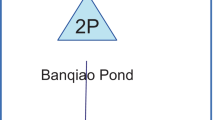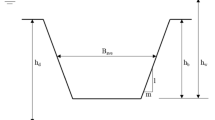Abstract
During the application of semi-theoretical models to predict peak discharges for breached embankment dams, it is often encountered to be lack of necessary model parameters such as breach height. In order to solve this deficiency and improve the application of the semi-theoretical models for estimating the peak discharge, a mathematical relation is proposed to predict the breach height (Hb) using the water depth above breach bottom (Hw) based on a subset of a composite database (72 historical dam failures). The breach height relation has a high coefficient of determination (R2) when it is applied in the composite database. Using the prediction by the breach height relation as a substitute for the observation, these semi-theoretical models used here produce similar results in terms of both prediction accuracy and uncertainty. Moreover, the dispersion of the flood peak discharge predicted by forecasting models is weakened and the skewness is improved by adopting the breach height relation. Therefore, the application of semi-theoretical models to predict peak discharges can be improved obviously. So, it is found that the breach height using the proposed relation can be a satisfactory substitute when the observed value of Hb is unavailable in a dam failure. Besides, the prediction accuracy will decrease slightly with the increase of database, but the decrease is limited. It should be noted that the proposed breach height relation is only suitable for predicting the height of embankment dam breach in principle.








Similar content being viewed by others
Abbreviations
- B avg :
-
Average width of the final breach
- E l :
-
Embankment length
- E w :
-
Average embankment width
- e i :
-
Individual prediction error
- e m :
-
Mean prediction error in logarithmic scale
- g :
-
Gravitational acceleration
- H b :
-
Breach height
- H d :
-
Dam height
- H w :
-
Water depth above breach bottom at time of failure
- IQR :
-
Interquartile range
- K m :
-
Factor accounting for failure mode
- k :
-
Vertical erosion rate of the breach
- M l :
-
Breach left-slope ratio
- M r :
-
Breach right-slope ratio
- m :
-
Average breach side-slope ratio
- Q p :
-
Peak outflow
- Q pmax :
-
Maximum possible peak discharge
- Q pri :
-
ith predicted peak discharge
- Q obi :
-
ith observed peak discharge
- Q obm :
-
Mean of the observed peak discharges
- Q1, Q3 :
-
Upper and lower quartiles
- Q 2 :
-
Median
- q :
-
Combinative parameter of the cross-section
- R 2 :
-
Coefficient of determination
- RRMSE :
-
Relative root mean square error
- S e :
-
Standard deviation of the errors
- T f :
-
Breach formation time
- V s :
-
Reservoir storage
- V w :
-
Volume of water stored above breach bottom at time of failure
- W :
-
Characteristic parameter of the flow depth
- α 0 :
-
Exponent of the level reservoir-volume curve
- α, β :
-
Coefficients in Froehlich’s formula
- η :
-
Dimensionless parameter in formula of Walder and O’Connor
- υ e :
-
Characteristic velocity in formula of De Lorenzo and Macchione
- σ :
-
Standard error of prediction
- ζ :
-
Coefficient in formula of Wang et al.
References
Wang B, Chen YL, Wu C, Peng Y, Song JJ, Liu WJ, Liu X (2018) Empirical and semi-analytical models for predicting peak outflows caused by embankment dam failures. J Hydrol 562:692–702. https://doi.org/10.1016/j.jhydrol.2018.05.049
Kirkpatrick GW (1977) Evaluation guidelines for spillway adequacy. The evaluation of dam safety, engineering foundation conference of ASCE, New York, pp 395–414
Soil Conservation Service (SCS) (1981) Simplified dam-breach routing procedure. Technical release no. 66 (Rev. 1), p 39
Hagen VK (1982) Re-evaluation of design floods and dam safety. In: Proceedings 14th congress of international commission on large dams, international commission on large dams, Paris
Bureau of Reclamation (1982) Guidelines for defining inundated areas downstream from Bureau of Reclamation dams. Reclamation planning instruction no. 82-11, U.S. Department of the Interior, Bureau of Reclamation, Denver
MacDonald TC, Langridge-Monopolis J (1984) Breaching characteristics of dam failures. J Hydraul Eng 110:567–586. https://doi.org/10.1061/(ASCE)0733-9429(1984)110:5(567)
Soil Conservation Service (SCS) (1985) Earth dams and reservoirs. U.S. Dept. of Agriculture, Washington, DC
Costa JE (1985) Floods from dam failures. U.S. Geological survey, Open-file report no. 85-560, Denver
Evans SG (1986) The maximum discharge of outburst floods caused by the breaching of man-made and natural dams. Can Geotech J 23:385–387. https://doi.org/10.1139/t86-053
Froehlich DC (1995) Peak outflow from breached embankment dam. J Water Res Plan Man 121:90–97. https://doi.org/10.1061/(ASCE)0733-9496(1995)121:1(90)
Webby MG (1996) Discussion of “Peak outflow from breached embankment dam” by David C. Froehlich. J Water Res Plan Man 122:316–317. https://doi.org/10.1061/(ASCE)0733-9496(1996)122:4(316)
Walder JS, O’Connor JE (1997) Methods for predicting peak discharge of floods caused by failure of natural and constructed earth dams. Water Resour Res 33:2337–2348. https://doi.org/10.1029/97WR01616
Pierce MW (2008) Predicting peak outflow from breached embankment dams. M.S. thesis, Colorado State Univ., Fort Collins, Colo
Macchione F (2008) Model for predicting floods due to earthen dam breaching. I: formulation and evaluation. J Hydraul Eng 134:1688–1696. https://doi.org/10.1061/(ASCE)0733-9429(2008)134:12(1688)
Macchione F, Rino A (2008) Model for predicting floods due to earthen dam breaching. II: comparison with other methods and predictive use. J Hydraul Eng 134:1697–1707. https://doi.org/10.1061/(ASCE)0733-9429(2008)134:12(1697)
Xu Y, Zhang LM (2009) Breaching parameters for earth and rockfill dams. ASCE J Geotechn Geoenviron Eng 135(12):1957–1970. https://doi.org/10.1061/(ASCE)GT.1943-5606.0000162
Pierce MW, Thornton CI, Abt SR (2010) Predicting peak outflow from breached embankment dams. J Hydrol Eng 15:338–349. https://doi.org/10.1061/(ASCE)HE.1943-5584.0000197
Thornton CI, Pierce MW, Abt SR (2011) Enhanced predictions for peak outflow from breached embankment dams. J Hydrol Eng 16:81–88. https://doi.org/10.1061/(ASCE)HE.1943-5584.0000288
Gupta SK, Singh VP (2012) Discussion of “enhanced predictions for peak outflow from breached embankment dams” by Christopher I. Thornton, Michael W. Pierce, and Steven R. Abt J Hydrol Eng 17:463–466. https://doi.org/10.1061/(ASCE)HE.1943-5584.0000470
Hooshyaripor F, Tahershamsi A, Golian S (2014) Application of copula method and neural networks for predicting peak outflow from breached embankments. J Hydro-Environ Res 8:292–303. https://doi.org/10.1016/j.jher.2013.11.004
De Lorenzo G, Macchione F (2014) Formulas for the peak discharge from breached earthfill dams. J Hydraul Eng 140:56–67. https://doi.org/10.1061/(ASCE)HY.1943-7900.0000796
Azimi R, Vatankhah AR, Kouchakzadeh S (2015) Predicting peak discharge from breached embankment dams. In: E-Proceedings, 36th IAHR world congress, Hague, Netherlands
Froehlich DC (2016) Predicting peak discharge from gradually breached embankment dam. J Hydrol Eng 21:04016041. https://doi.org/10.1061/(ASCE)HE.1943-5584.0001424
Wang B, Chen YL, Wu C, Dong JH, Ma X, Song JJ (2016) A semi-analytical approach for predicting peak discharge of floods caused by embankment dam failures. Hydrol Process 30:3682–3691. https://doi.org/10.1002/hyp.10896
Wahl TL (1998) Prediction of embankment dam breach parameters: a literature review and needs assessment. Dam safety report no. DSO-98-004, U.S. Department of the Interior, Bureau of Reclamation, Denver
Hooshyaripor F, Tahershamsi A (2012) Comparing the performance of neural networks for predicting peak outflow from breached embankments when back propagation algorithms meet evolutionary algorithms. Int J Hydraul Eng 1:55–67. https://doi.org/10.5923/j.ijhe.20120106.01
International Commission on Large Dams (1974) Lessons from dam incidents, Paris
Froehlich DC (2017) Closure to “predicting peak discharge from gradually breached embankment dam” by David C. Froehlich. J Hydrol Eng 22:07017008. https://doi.org/10.1061/(ASCE)HE.1943-5584.0001532
Froehlich DC (2008) Embankment dam breach parameters and their uncertainties. J Hydraul Eng 134:1708–1721. https://doi.org/10.1061/(ASCE)0733-9429(2008)134:12(1708)
Acknowledgements
The first author would like to thank for the National Key Research and Development Program of China (Grant No: 2018YFC1505000), the financial support of National Natural Science Foundation of China (Grant No: 51879179) and the Sichuan Provincial Youth Science and Technology Innovation Research Team Special Funding Project (No: 2019JDTD0007). The sixth author would like to thank for the financial support of National Natural Science Foundation of China (Grant No: 51579166).
Author information
Authors and Affiliations
Corresponding author
Ethics declarations
Conflict of interest
The authors declare that they have no conflict of interest.
Additional information
Publisher's Note
Springer Nature remains neutral with regard to jurisdictional claims in published maps and institutional affiliations.
Rights and permissions
About this article
Cite this article
Wang, B., Liu, W., Zhang, J. et al. Enhancement of semi-theoretical models for predicting peak discharges in breached embankment dams. Environ Fluid Mech 20, 885–904 (2020). https://doi.org/10.1007/s10652-019-09730-9
Received:
Accepted:
Published:
Issue Date:
DOI: https://doi.org/10.1007/s10652-019-09730-9




